The K-27 is the first Large Scale locomotive with totally isolated electronics, which allows for easy installation of the control system of your choice.
There are two set of switches; the lighting switches behind the smokebox door at the front of the locomotive, and the control switches underneath the coal load in the tender on the main PC board.

Smoke Box Switches
There are three switches behind the smokebox door at the front of the locomotive.
- Smoke - Controls the smoke unit
- Cab light - Controls the cab light
- M.L. & F.F. - Controls the classification lights and firebox flicker
Each switch has a DCC position, a DC position, and a center off position
- DC position: In the DC position the specified function is always on
- DCC operation: In the DCC position the specified function is controlled through the socket on the main PC board in the tender
- OFF position: In the OFF position the specified function is always off
Tender Switches
There are three switches on the main PC board in the tender. To access these switches pull up on the front panel on the tender and remove the coal load.
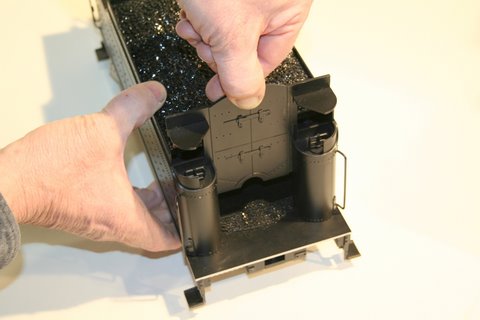
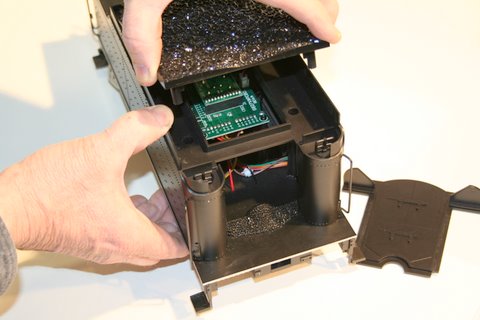
Pick Up Switch (top): In the “Track” position, track power is fed from the
tracks through the track Polarity switch to the electronics inside the
locomotive. In the “Battery” position, all track connections are removed and all
the power is fed through the two screw terminals just to the left of the Pick Up
switch.
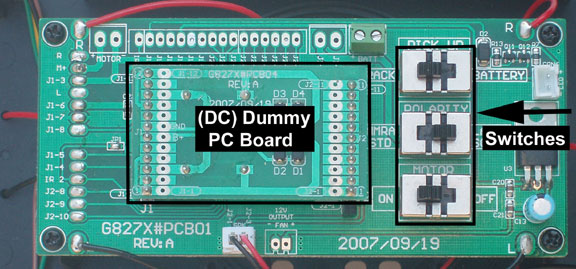 Track Polarity Switch (middle): In Large Scale, there are
two conventions used to control the direction of the locomotive. For Left Rail
positive control (the most common in use) switch the Polarity switch to the
“Large Scale” position. For Right Rail positive control, switch the Polarity
switch to the “NMRA”
Track Polarity Switch (middle): In Large Scale, there are
two conventions used to control the direction of the locomotive. For Left Rail
positive control (the most common in use) switch the Polarity switch to the
“Large Scale” position. For Right Rail positive control, switch the Polarity
switch to the “NMRA”
position. If your locomotive operates in the reverse direction to other locomotives on your layout, place the Polarity switch in the opposite position.
Motor Switch (bottom): This switch controls the motor. When “Off” the locomotive will not move, but the lighting and other features of the locomotive, such as smoke or lighting, will continue to function.
Plug-and-Play Socket
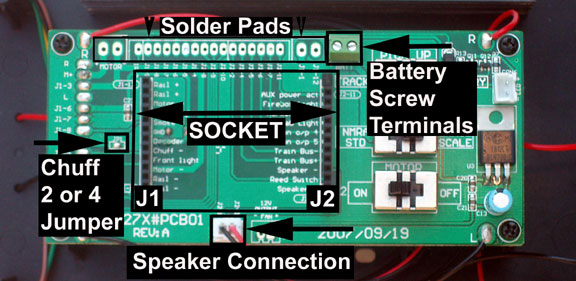 The Bachmann K-27 comes equipped with an open and
nonproprietary plug-and-play electronics socket. This plug-and-play socket is
designed for after market plug-and-play products (contact your hobby retailer
for more information). As delivered, the K-27 is set up for DC operation.
The Bachmann K-27 comes equipped with an open and
nonproprietary plug-and-play electronics socket. This plug-and-play socket is
designed for after market plug-and-play products (contact your hobby retailer
for more information). As delivered, the K-27 is set up for DC operation.
Track Powered DC Operations
The K-27 is factory-equipped with a (DC) Dummy PC Board plugged in the plug-and-play socket. To operate the K-27, leave the (DC) Dummy PC Board in place, make sure that the Motor switch is “On”, the Pick Up switch is in the “Track” position, and the track Polarity switch is set for its correct position (normally the “Large Scale” position). In this mode, the locomotive headlight and the tender rear light will be direction dependent. Control of smoke and other lighting functions can be obtained via the switches behind the smoke box door.
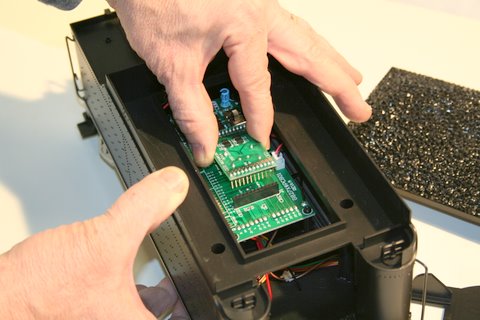
Replacing the (DC) Dummy PC Board
To replace the (DC) Dummy PC Board with a plug-and-play system of your choice, simply lift out the (DC) Dummy PC Board and carefully insert the
replacement plug-and-play PC board in the empty socket (figure 19, 20). The J1 row of pins (towards the front of the tender) and the J2 row of pins (towards the rear of the tender) on the socket must be aligned properly with the replacement plug-and-play PC board.
Pin Definitions
Each pin on the plug-and-play socket has a defined purpose and is labeled on the socket under the (DC) Dummy PC Board. Each pin is also connected to a solder pad for use with systems that do not support plug-and-play. The following table provides the purpose for each pin. The J2 row of pins has a blank key on either end of the row to help ensure that a plug-and-play device can not be incorrectly inserted.
| J1 Pin Number | Purpose | J2 Pin Number | Purpose |
|---|---|---|---|
| 12 | Rail + | 12 | Solid Key |
| 11 | Rail + | 11 | Not used |
| 10 | Motor + | 10 | Firebox Flicker |
| 9 | Rear Light on Tender | 9 | Classification Lights |
| 8 | Smoke Unit | 8 | Cab Light |
| 7 | Locomotive Ground | 7 | Not used |
| 6 | Locomotive Positive | 6 | Not used |
| 5 | Chuff | 5 | Train Bus - |
| 4 | Front Locomotive Headlight | 4 | Train Bus + |
| 3 | Motor - | 3 | Speaker - |
| 2 | Rail - | 2 | Not used |
| 1 | Rail - | 1 | Speaker + |
Adding an Aftermarket Sound System
If your sound system is designed for plug-and-play operation, remove the (DC) Dummy PC Board, plug in your sound system, and install a 3" speaker in the speaker location beneath the main PC board in the tender. To aid in this installation, a pair of wires from the speaker connection on the main PC board in the tender to the speaker is provided. If your sound system does not provide plug-and-play operation, continue to use the (DC) Dummy PC Board in the tender and connect the sound system wires to the solder pads on the engineer’s side (right hand side of tender if looking forward) of the main PC board in the tender.
To install a speaker in the tender first remove the tender shell. To remove the tender shell:
- Remove the two screws at the front of the tender underneath the coal load.
- Remove the single screw under the rear hatch on the top of the tender shell.
- Carefully lift off the tender shell.
The speaker is intended to be mounted underneath the main PC board. To gain access to this area, remove the four screws on the four corners of the main PC board and carefully move the main PC board to one side.
To install the speaker, solder the speaker connector wires to the speaker terminals (the J2-1 wire is connected to the speaker’s + terminal) and use the four mounting screws to secure the speaker to the tender floor. The speaker should not touch the main PC board when reinstalled in the tender.
Once the speaker is installed, replace the four screws on the main PC board removed above, plug in the speaker to its connection on the main PC board in the tender, and reinstall the tender shell.
The K-27 is designed to support either two or four chuffs per revolution. From the factory, four chuffs per revolution is selected. For two chuffs per revolution, remove the chuff jumper connection, which is labeled JP1.
Adding Aftermarket Track-Powered NMRA DCC Operation
If your NMRA DCC decoder is designed for full plug-and-play operation with the plug-and-play socket, remove the (DC) Dummy PC Board and replace it with your plug-and-play decoder.
Some decoders do not support all of the functions contained on the J2 connection. In this case, follow the decoder manufacturer’s instructions for connecting the decoders auxiliary functions to the solder pads on the engineer’s side of the main PC board (right hand side of tender if looking forward).
Phoenix P5 Sound Decoder Install
Adding Aftermarket On-Board Battery/RC Operation
If your Battery/RC or DCC Direct system supports plug-and-play using the plug-and-play socket, remove the (DC) Dummy PC Board and replace it with the plug-and-play board of your choice. Install the batteries in the tender, connect the batteries to the battery screw terminals on the plug-and-play socket and switch the Pick Up switch to “Battery.”
If your Battery/RC system does not support plug-and-play operation, then the simplest conversion is to connect the motor outputs of your RC system to the battery screw terminals. Should you wish to control the locomotive’s individual lighting and smoke functions, follow the specific manufacturer’s instructions for connection of the K-27 functions to the control system’s function outputs.
Remote Control System's RCS PnP board Install
Remote Control System's EVO PnP board Install
Hybrid Drive Operation
Some control systems use a combination of on-board primary or backup power to power the locomotive with the control signal being transmitted either through the track or via radio control. To install such systems, connect the onboard power ground terminal to J1-7 and the onboard power positive terminal to J1-6. The remaining connections are through the plug-and-play socket or soldered directly to the solder pads on the engineer’s side (right hand side of tender if looking forward) of the main PC board in the tender. These systems also allow for the control signal to come either from the track or from a radio receiver. If using such a system, connect the radio receiver outputs to the battery screw terminals, and use the Pick Up switch to select “track” for track signal or “Battery” for radio signal.
Thank you again for purchasing the Bachmann Spectrum K-27 2-8-2 locomotive. Be sure to fill out and send in your warranty card. You can check out all of Bachmann’s other large scale products at your local hobby retailer or at www.bachmanntrains.com.
CONTENTTEXT; ?>
